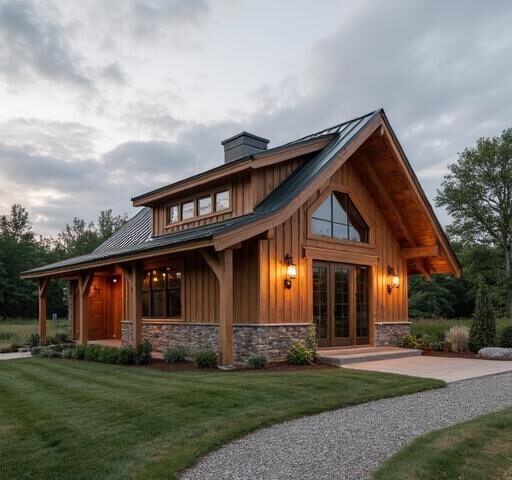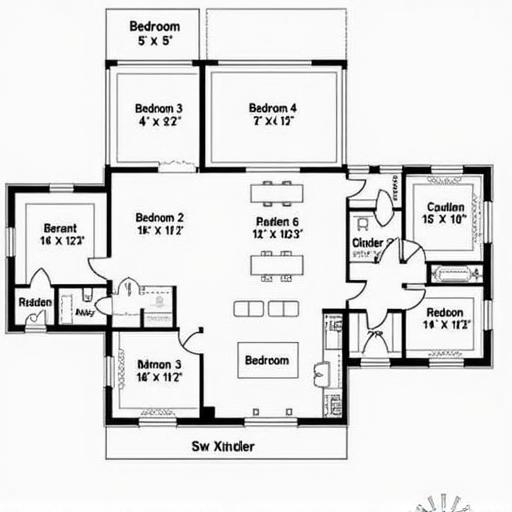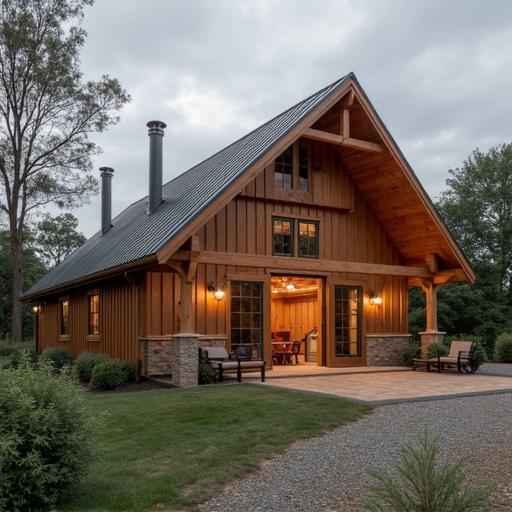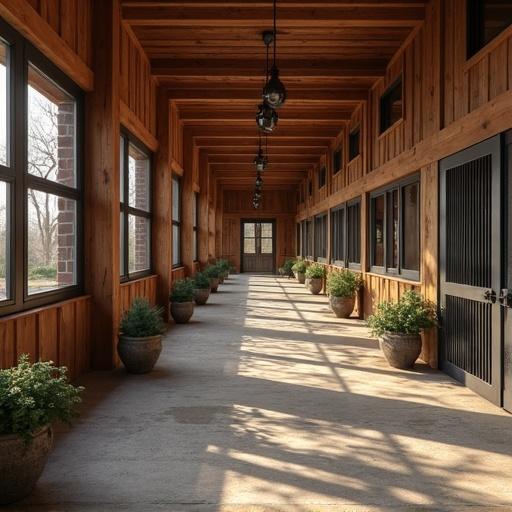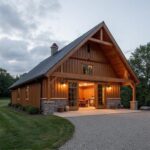
Barndominium Cost to Build: Affordable Dreams Await
July 31, 2025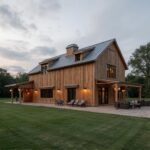
L Shaped Barndominium: Transform Your Dream Space Today
August 1, 2025Barndominium financing opens the door to a unique housing option that’s capturing the hearts of many prospective homeowners. A barndominium is a blend of a barn and a condominium, offering spacious living areas with rustic charm and modern amenities.
As more individuals seek alternatives to traditional homes, the popularity of barndominiums continues to rise, thanks in part to their adaptability and affordability. Featuring open floor plans, high ceilings, and energy-efficient designs, barndominiums provide an inviting lifestyle that marries the comfort of home with the aesthetic appeal of rural architecture.
One defining characteristic of barndominiums is their construction method. Typically built from metal or wood framing, these structures are often less costly to build than conventional houses yet maintain high durability and insulation properties. This unique construction process allows for creative interior design options while maximizing living space.
Furthermore, many owners appreciate the low maintenance costs associated with these buildings compared to traditional homes. Consequently, they have gained traction among those looking for affordable housing solutions that don’t compromise on style or functionality.
The growing trend of barndominiums has led to an increasing demand for specialized financing options tailored specifically for these non-traditional homes. As potential buyers navigate their dream of building or purchasing a barndominium, understanding the intricacies of financing becomes crucial.
Not only do borrowers need to be aware of different loan types available for such structures, but they also need insight into how these loans differ from conventional mortgage options. With more lenders recognizing the appeal and value of barndominiums as viable housing solutions, this article aims to guide readers through everything they need to know about securing financing for their dream dwelling today.
Understanding Barndominium Financing
Barndominium financing is an essential topic for those interested in transforming their dreams of rural living into reality. At its core, financing a barndominium involves securing a loan to cover the costs associated with purchasing land and constructing or converting a barn into a livable space.
This concept has gained traction as more individuals and families look for affordable alternatives to traditional homes, combining rustic charm with modern amenities. However, it is critical to understand how barndominium financing differs from conventional home mortgages in order to navigate this process successfully.
One key difference between traditional home financing and barndominium financing lies in the type of properties recognized by lenders. While most lenders are familiar with single-family homes and typical residential buildings, barndominiums often present unique challenges due to their hybrid structure.
Many financial institutions have specific guidelines pertinent to assessing these types of properties since they may fall under different zoning laws compared to standard houses. Additionally, some lenders may require more extensive documentation relating to building plans or contractor quotes due to the construction nature of many barndominiums.
Another significant factor affecting your financing options is the type of loan you choose. Several avenues are available when seeking funding for your barndominium project-the most common being conventional loans, construction loans, and USDA loans tailored for rural development. Each option carries distinct advantages and disadvantages that could influence your decision based on budgets and timelines.
For example, construction loans are typically short-term solutions designed to finance the build process but may require higher down payments or interest rates compared to traditional fixed-rate mortgages. Thoroughly evaluating these choices will help determine which path provides the best foundation for achieving your dream home.
| Type of Loan | Advantages | Disadvantages |
|---|---|---|
| Conventional Loans | Lower interest rates; longer repayment terms. | Less flexibility regarding property type recognition. |
| Construction Loans | Covers building costs directly; can convert into permanent mortgage. | Higher down payments; may have variable interest rates. |
| USDA Loans | No down payment required; geared towards rural developments. | Eligibility limitations based on income; property must meet certain criteria. |
Understanding these nuances within barndominium financing prepares prospective homeowners not only for successful applications but also establishes realistic expectations during their journey toward ownership. Being well-informed allows future buyers to seek appropriate financial arrangements tailored specifically for a unique housing style like barndominiums without unnecessary surprises along the way.
Types of Barndominium Financing Options
Barndominium financing presents a unique opportunity for prospective homeowners eager to create a distinctive living space. As barndominiums blend the rustic charm of traditional barns with modern living amenities, understanding the various financial options available is essential to turning this dream into reality. This section explores the different types of financing options tailored specifically for barndominiums, each offering distinct benefits and potential drawbacks.
Conventional Loans
One popular option for financing a barndominium is through conventional loans. These loans are typically offered by banks or credit unions and are not backed by government entities. A major advantage of using conventional loans for barndominiums is that they tend to offer competitive interest rates and flexible terms.
However, obtaining approval can be more challenging compared to other financing methods since lenders often require a higher credit score and larger down payments. Additionally, it’s crucial for borrowers to ensure that their specific property meets lender standards, as these requirements can vary widely.
Construction Loans
For those looking to build their barndominium from scratch, construction loans may be a suitable choice. These short-term loans cover costs associated with constructing the home and are disbursed in stages as different phases of the building process are completed.
While construction loans provide ample funding for new builds, they often come with higher interest rates and additional fees compared to traditional home mortgages. It’s also important to remember that once construction is complete, borrowers will likely need to refinance into a permanent mortgage loan-transforming the temporary financing into long-term stability.
USDA Loans
Another viable option for financing a barndominium is through USDA loans aimed at rural development initiatives. These government-backed loans offer favorable terms such as no down payment requirements and lower mortgage insurance premiums, making them an attractive solution for eligible buyers in rural areas where many barndominiums are situated.
However, USDA loans come with specific eligibility criteria focused on income limitations and geographical location that must be considered before proceeding with this type of financing. Understanding these nuances can help potential homeowners determine whether USDA loans align well with their financial situation.
Each type of barndominium financing has unique attributes catering to different needs; hence it’s vital for buyers to assess their personal circumstances thoroughly before making any commitments.
Eligibility Requirements for Barndominium Financing
To successfully secure barndominium financing, prospective buyers must navigate various eligibility requirements that lenders typically impose. These criteria can play a significant role in determining whether a borrower can obtain a loan to construct or purchase their dream barndominium. One of the primary factors influencing eligibility is a borrower’s credit score, which reflects their financial history and ability to manage debt responsibly. Generally, lenders prefer a credit score of at least 620; however, certain programs may have different thresholds.
Another crucial requirement is income verification. Lenders seek assurance that borrowers possess stable and sufficient income to repay the loan over time. This could involve providing recent pay stubs, tax returns, or bank statements as proof of financial stability. Additionally, lenders will often assess the borrower’s debt-to-income (DTI) ratio – which should ideally be under 43% – to ensure that they are not stretching their finances too thin when taking on new debt like barndominium financing.
Lastly, down payments also heavily influence eligibility for barndominium loans. While some traditional home loans may require as little as 3% down, barndominium financing often demands at least 20%, especially for those seeking conventional loans or constructing new builds from scratch. It’s beneficial for potential borrowers to prepare ahead by saving for this upfront investment and ensuring all necessary documentation is at hand before initiating the lending process.
| Eligibility Criteria | Details |
|---|---|
| Credit Score | Generally at least 620; varies by loan type |
| Income Verification | Recent pay stubs, tax returns, bank statements required |
| Debt-to-Income Ratio (DTI) | Ideally below 43% |
| Down Payment | Typically at least 20%, varies by lender and loan type |
Calculating Costs of Building a Barndominium
Estimating Total Construction Costs
When considering the financial aspect of building a barndominium, one of the first steps is to estimate the total construction costs. Unlike traditional homes, barndominiums often come with unique features and construction requirements that can influence overall expenses. The primary costs associated with building a barndominium typically include land acquisition, materials for construction, and labor costs. To get an accurate picture of what you might need to finance, it’s crucial to account for each element systematically.
For instance, land prices can vary greatly depending on location. If you’re planning to build in a rural area, you might find more affordable options; however, urban or suburban areas will often present higher land prices. After securing your plot, you’ll want to focus on estimating material costs which can fluctuate based on current market conditions and your design choices. Additionally, if you’re opting for custom features or high-end finishes, this could significantly impact your budget.
Labor costs also play a critical role in calculating the total expense of your project. Hiring experienced contractors who specialize in barndominium construction may lead to higher upfront costs but could save you money over time through efficient work and minimized delays. Moreover, it’s advisable to gather multiple quotes from different builders before settling on one-this helps you not only secure competitive pricing but also allows you to establish trust and communication early in the process.

Impact on Financing Options
Once you’ve navigated through estimating the total cost of building your barndominium, these figures will profoundly influence your financing options. Barndominium financing typically emphasizes how much money you’ll require based on your projected expenses. Therefore, understanding all facets of potential construction costs allows lenders to assess risk effectively when providing loans.
If you discover that costs exceed initial expectations after including permits and utility installations-essential aspects often overlooked during early calculations-you may need to adjust your financing plan accordingly. This might mean seeking out additional financing or even modifying design plans to fit within a more manageable budget range. Many lenders encourage applicants to present detailed cost analyses when applying for barndominium financing since it gives them confidence in approving loans tailored specifically for these distinctive homes.
Additionally, understanding capital needs may uncover benefits such as better leveraging options within specific loan products available solely for building types like barndominiums versus conventional homes. Overall, precise estimations are crucial not only for securing appropriate financing but also for ensuring peace of mind throughout the home-building journey as they set realistic expectations from start to finish.
Pre-Approval Process for Barndominium Financing
The pre-approval process for barndominium financing is a crucial initial step in securing the necessary funds to make your dream home a reality. This stage involves assessing your financial situation and determining how much you can borrow, which significantly influences your budget and choice of properties. The pre-approval process typically begins with selecting a lender who understands the unique aspects of barndominiums, as this can affect the financing options available.
When applying for pre-approval, borrowers will generally need to provide several key documents to their lender. These typically include:
- Proof of Income: Recent pay stubs, W-2s, or tax returns help demonstrate your ability to repay the loan.
- Credit History: Lenders will review your credit score and history to assess risk and establish loan terms.
- Debt-to-Income Ratio: This is calculated by comparing monthly debt payments to gross monthly income, helping lenders evaluate your financial stability.
- Assets Documentation: Statements showing savings, checking accounts, and other assets may be required to ascertain your overall economic standing.
A critical component of this process is obtaining a detailed quote from the lender regarding interest rates and terms. Many factors influence these rates, including current market conditions and individual credit scores. By securing pre-approval early on, you not only clarify your budget but also showcase seriousness to sellers when negotiating potential purchases. Without pre-approval, you might face hurdles finding favorable financing later on or miss out on opportunities due to uncertainty about what you can afford.
Moreover, it’s essential for prospective homeowners to consult with lenders experienced in barndominium financing specifically. They can offer insights into additional considerations that traditional lenders might overlook given that barndominiums combine elements of residential homes with agricultural designs. Understanding these nuances could save time and enhance approval chances.
Choosing the Right Lender for Your Barndominium
When embarking on the journey to finance your barndominium, selecting the right lender is crucial. Not all lenders are well-versed in the distinct characteristics and requirements that pertain to barndominium financing. Therefore, it’s essential to find a financial institution or mortgage broker with experience specifically related to this type of construction. Barndominiums often differ from traditional homes in both design and financing needs, making it vital to work with someone who understands these nuances.
Here are some considerations when choosing a lender for your barndominium financing:
- Experience and Specialization: Look for lenders who have a track record of approving loans specifically for barndominiums. They will be more familiar with appraising non-traditional structures and could help you navigate any unique challenges.
- Interest Rates and Terms: Compare the interest rates offered by various lenders, as well as their loan terms. Even small differences can add up over time, significantly affecting your overall cost. Pay attention to whether they offer fixed or adjustable rates and what fees may be associated with each option.
- Customer Service Quality: Lender reputation matters, especially during the often stressful process of obtaining financing. Check reviews or ask for recommendations from other barndominium owners about their experiences regarding responsiveness, support throughout the application process, and willingness to help resolve issues.
Once you’ve done thorough research on potential lenders, take note of their respective requirements since eligibility can vary widely among financial institutions. It may also be beneficial to consult with financial advisors familiar with barndominium projects before making your final choice. Understanding their perspectives can give extra confidence in navigating your loan options effectively.
Navigating Challenges in Barndominium Financing
Embarking on the journey to finance a barndominium can be exciting, yet it is not without its challenges. Many potential homeowners may find themselves facing unique hurdles that are less prevalent in traditional home financing.
One common challenge involves securing a loan that fits the distinct structure of a barndominium, which can sometimes lead to complexities in appraisals and underwriting processes. Unlike standard homes, lenders may have limited experience with barndominiums, resulting in additional scrutiny or a lack of standardized procedures for assessing their value.
Another significant challenge lies in finding lenders who specialize in barndominium financing. Traditional mortgage banks might not recognize the value that these structures provide compared to those constructed from conventional materials.
This can lead prospective buyers to explore multiple financial institutions and potentially face rejections due to misunderstandings about what constitutes an appropriate collateral for the loan. Understanding how different lenders evaluate barndominiums is crucial for overcoming this obstacle; engaged research into lenders experienced with such properties can ease this process substantially.
Additionally, applicants often encounter issues related to down payments and credit assessments. Since lending institutions usually perceive barndominiums as unconventional builds, they may require higher down payments-often exceeding 20%-to mitigate perceived risks. Navigating through high down payment demands alongside maintaining an adequate credit score becomes essential for moving forward with financing plans.
It’s advisable for borrowers to maintain clear records of income and savings and ensure their credit history reflects responsible financial behaviors prior to initiating any loan applications. By preparing ahead of time and considering strategies like pre-approval processes or seeking professional advice from real estate experts, borrowers can turn what might seem like intimidating challenges into manageable steps towards securing their dream barndominium.
Conclusion
Barndominiums are increasingly capturing the interest of potential homeowners due to their unique blend of rustic charm and modern functionality. These hybrid builds, often incorporating both living quarters and workspaces under one roof, provide a versatile option that caters to various lifestyles.
With high ceilings, open floor plans, and a plethora of customizable design options, barndominiums set themselves apart from traditional homes. They not only offer a distinct aesthetic but also promise practicality with energy efficiency and lower maintenance costs-a combination that is hard to resist in today’s housing market.
The financing process for a barndominium can differ significantly from that of a standard home. Many lenders still operate within traditional financing frameworks; however, as the popularity of barndominiums grows, specialized financing options have emerged.
Barndominium financing may require different considerations such as land type, construction methods used (for instance, steel versus wood framing), and whether the property will be used as a primary residence or for investment purposes. Understanding the intricacies of these financial options is essential for securing favorable terms.
In light of these differences, it’s critical to take a structured approach to your barndominium financing journey. Start by assessing your overall budget including construction costs-land acquisition, materials, labor-and ongoing expenses such as utilities and repairs.
Conducting thorough research on available financing options such as conventional loans or specific construction loans tailored for barndominiums will allow you to identify the best fit for your situation. Armed with this knowledge, you’ll be better prepared to navigate through pre-approval processes and lender negotiations effectively while ensuring you’re getting the most advantageous terms possible for your new living space.
Call to Action
Barndominium financing represents a wonderful opportunity for those looking to turn their dream of owning a unique, affordable home into reality. By blending the charm of rustic living with modern amenities, barndominiums offer an enticing alternative to traditional residences.
In an era where financial flexibility and creativity are highly valued, securing the right financing is crucial in making this vision attainable. Understanding how to navigate the specific challenges associated with barndominium financing equips potential homeowners with the tools they need to succeed.
As you consider embarking on your journey toward building a barndominium, it is vital to be informed about the various financing options available. Whether you’re leaning towards conventional loans or contemplating construction loans tailored for these structures, knowing the particulars will empower you to make informed decisions. Every lender has unique criteria and assesses applications differently; thus, being proactive in gathering necessary documentation and understanding eligibility requirements can streamline your application process significantly.
Ultimately, taking the first steps toward your dream barndominium begins with reaching out for assistance. Engage with financial advisors or specialized lenders who can guide you through each stage of financing-from pre-approval to selecting the best lending options tailored for your needs.
With thorough research and open communication, you’ll not only unlock effective financing solutions but also pave the way for a fulfilling experience in creating a home that truly reflects your desires. Embrace this opportunity-the ideal barndominium awaits.

